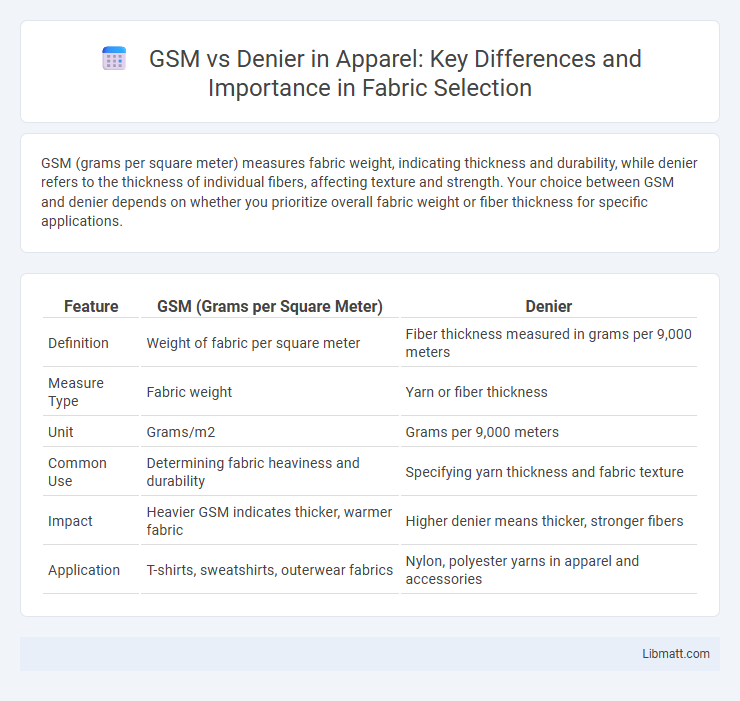GSM (grams per square meter) measures fabric weight, indicating thickness and durability, while denier refers to the thickness of individual fibers, affecting texture and strength. Your choice between GSM and denier depends on whether you prioritize overall fabric weight or fiber thickness for specific applications.
Table of Comparison
| Feature | GSM (Grams per Square Meter) | Denier |
|---|---|---|
| Definition | Weight of fabric per square meter | Fiber thickness measured in grams per 9,000 meters |
| Measure Type | Fabric weight | Yarn or fiber thickness |
| Unit | Grams/m2 | Grams per 9,000 meters |
| Common Use | Determining fabric heaviness and durability | Specifying yarn thickness and fabric texture |
| Impact | Heavier GSM indicates thicker, warmer fabric | Higher denier means thicker, stronger fibers |
| Application | T-shirts, sweatshirts, outerwear fabrics | Nylon, polyester yarns in apparel and accessories |
Introduction to GSM and Denier
GSM (Grams per Square Meter) measures fabric weight by quantifying the mass of a material per square meter, indicating its thickness and durability. Denier refers to the thickness of individual fibers or yarns, calculated by the mass in grams per 9,000 meters of fiber. Both GSM and Denier are essential metrics in textiles for evaluating fabric quality, with GSM related to overall fabric density and Denier focused on fiber fineness.
What is GSM?
GSM, or grams per square meter, measures fabric weight and density, indicating the heaviness of textiles such as cotton, polyester, or silk. This metric directly influences the fabric's thickness, durability, and opacity, with higher GSM fabrics typically used for premium upholstery, towels, and heavy clothing. Understanding GSM helps manufacturers and consumers assess textile quality and suitability for specific applications.
What is Denier?
Denier is a unit of measurement that quantifies the linear mass density of fibers, defined as the mass in grams per 9,000 meters of the fiber. It is commonly used to describe the thickness or fineness of yarns and threads in textiles, where a lower denier indicates finer fibers and a higher denier indicates thicker, more durable fibers. Understanding denier helps determine the suitability of fabric for different applications, such as lightweight clothing versus heavy-duty outdoor gear.
Key Differences Between GSM and Denier
GSM (grams per square meter) measures fabric weight, indicating the density of the textile, while denier quantifies the thickness of individual fibers in the fabric. GSM is used to determine fabric heaviness and suitability for applications like clothing or upholstery, whereas denier assesses fiber fineness, impacting texture and durability. Understanding both metrics helps in selecting textiles with the desired balance of weight, strength, and comfort.
How GSM Affects Fabric Quality
GSM (grams per square meter) directly influences fabric quality by determining its weight and durability, making higher GSM fabrics thicker and more resistant to wear. Compared to denier, which measures fiber thickness, GSM provides a more comprehensive assessment of overall fabric density and texture. Fabrics with optimized GSM values ensure better comfort, longevity, and performance in various applications such as apparel, upholstery, and technical textiles.
How Denier Influences Material Strength
Denier measures the thickness of individual fibers, directly impacting the strength and durability of a fabric. Higher denier values correspond to thicker fibers, resulting in stronger, more resilient materials that can withstand wear and tear. Your choice of denier depends on the required toughness and longevity for specific applications.
Practical Applications of GSM and Denier
GSM (grams per square meter) is predominantly used in the textile industry to measure fabric weight, crucial for determining material thickness and durability in applications like apparel, upholstery, and bed linens. Denier quantifies the linear mass density of fibers and yarns, making it essential for assessing strength and fineness in products such as hosiery, industrial threads, and outdoor fabrics. Understanding both GSM and denier enables manufacturers to select appropriate materials that balance comfort, performance, and durability for specific end uses.
Choosing Between GSM and Denier for Your Needs
Choosing between GSM (grams per square meter) and denier depends on the specific fabric characteristics you need: GSM measures fabric weight, ideal for assessing thickness and durability, while denier quantifies fiber thickness, influencing texture and strength. For heavier or more durable textiles like upholstery or outerwear, higher GSM is preferable; for lightweight, sheer fabrics like hosiery or lingerie, lower denier values matter more. Understanding these metrics ensures you select fabrics that meet performance requirements and aesthetic preferences for your project.
Advantages and Limitations of GSM and Denier
GSM (grams per square meter) accurately measures fabric weight, providing insight into material density and suitability for specific applications such as upholstery and clothing. Denier quantifies fiber thickness, influencing fabric strength and texture, making it ideal for assessing yarn durability in textiles like hosiery and outdoor gear. Limitations of GSM include its inability to indicate fiber thickness or fabric thickness, while denier does not account for overall fabric weight or density, requiring combined analysis for comprehensive fabric characterization.
Conclusion: GSM vs Denier – Which Matters More?
When comparing GSM (grams per square meter) and denier, GSM measures fabric weight, indicating thickness and durability, while denier quantifies fiber thickness, affecting texture and strength. Your choice depends on the fabric's end use: GSM is crucial for assessing overall material density, ideal for heavy-duty textiles, whereas denier is more relevant for lightweight fabrics requiring fineness and smoothness. Understanding both metrics helps you evaluate fabric quality accurately, but GSM generally matters more in determining the fabric's robustness and suitability for specific applications.
GSM vs denier Infographic

 libmatt.com
libmatt.com